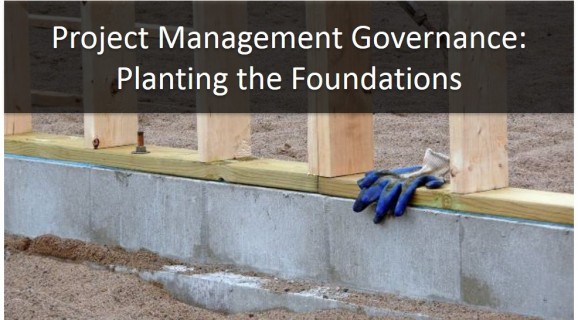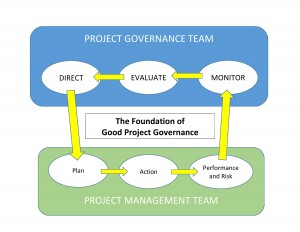
In my last article I looked at what PM governance is and discussed the basis for building a project management governance framework. I only touched on the three PM governance elements on which the framework stands, and want to expand upon these in this article.
How the Monitor – Evaluate – Direct model functions
A business will need a team that is responsible for project governance. This team will have overall responsibility for the success of the project, and ensuring that the project aligns with business strategy. Its focus, therefore, will be strategic: big picture rather than everyday nuts and bolts.
It will kick this process off by directing the project management team by describing aims and goals. The project management team then controls the project, as responsibility is delegated down to it for the realisation of these business goals. Throughout the project lifetime, the project management team will report back to the project governance team. These reports will inform of project values, risks, and performance. This information will be used by the governance team to iterate project direction. (click on image to enlarge)
Direct
The PM governance team directs the PM team with project objectives. Its job in this regard must take into account the size of the organisation, its business strategy, appetite for risk, and budgets. Direction given to the PM team will include:
- Policies
- Processes
Internally, the PM governance team will decide:
- Roles
- Project selection criteria
- Benefits analysis
- Risk management
Its direction of the project is itself iterated by the embedded system of monitoring and evaluation.
Monitor
The PM team reports directly to the PM governance team, enabling the PM governance team to monitor:
- Milestones
- Interdependencies between projects
- Change management
- Stakeholder engagement
- Resource management
- Assumptions
In this process the PM governance team will be able to better identify issues arising and move onto the next stage of the governance process:
Evaluate
Taking into all reports from the PM team, the PM governance team will be able to evaluate progress and iterate the project. This is an ongoing, continuous, and constant process, with direction to the PM team evolving throughout. The methodology of evaluation should be project appropriate and may include:
- PRINCE2
- Agile
- Scrum
- Waterfall
- Extreme
- V Model
Benefits of the PM governance model
Through the continuous and constant monitoring, evaluation, and redirection by the PM governance team, projects will evolve on a gradual change basis. This reduces shocks, enables better management, and is a system that enables proactive budget management.
Next time we’ll look more closely at the PM governance model and segregation of roles and responsibilities.


